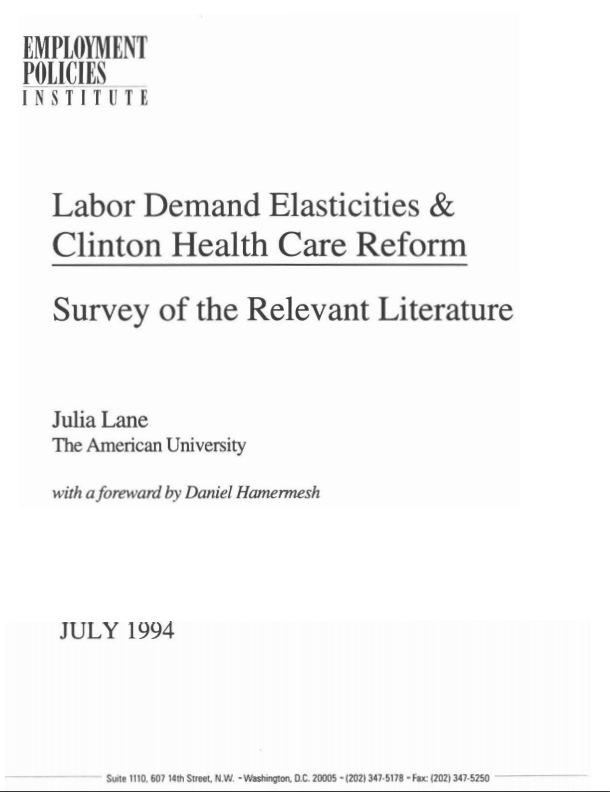At a White House press conference in October of 1993, Secretary of Labor Robert Reich and Laura D’Andrea Tyson, Chair of the Council of Economic Advisors, released a paper criticizing estimates of job losses from employer mandates to pay for health care reform.1
A specific target of their criticism was a study—The Impact of a Health insurance Mandate on Labor Costs and Employment—carried out by Drs. June and Ave O”Neill and published by the Employment Policies Institute. That report, as well as the follow-up study—Effects of the Employer Mandate in the Clinton Health Plan—which analyzed the Clinton plan directly, relied on prevailing economic knowledge to model the effects of a mandate. The report assumed that, economy-wide, employers would reduce their workforces by 3 percent for every ten percent increase in costs from the mandate; highly affected industries (those with large numbers of low-wage workers) would respond more drastically and reduce employment by 5 percent.
The White House charged that these response factors (“elasticities”) were grossly exaggerated and that the job losses predicted in those reports could only be arrived at by distorting conventional economic theory. To quote from the White House paper:
The assumption about how firms change their employment in response to cost changes is three to six times higher than most conventional estimates. The O’Neill study assumes that firms will lay off 3% of their workforce if compensation rises by 10%.
o Summary estimates in the economic literature, for example by Charles Brown and Allison Wellington, suggest that the responsiveness of firms to cost changes for low-wage workers is only one-third to one-sixth of the O’Neill assumption (emphasis in original).2
In response to the Clinton Administration’s criticism, we asked Dr. Julia Lane of American University to review the literature on employment response. Her findings confirm that the labor market responses assumed in the O’Neill paper are not only well supported by mainstream economic thought, but also are conservative in that they represent the mid-point of accepted values. Her findings, echoed by Dr. Daniel Hamermesh of the University of Texas at Austin in his foreword, demonstrate that accepted economic thought on labor response calls for a reduction of anywhere between 1.5 and 7.5 percent of employees in response to a 10 percent increase in cost. These widely accepted values evenly bracket the estimates used by the O’Neills—3 and 5 percent—in arriving at their predicted job loss.
The Institute stands by the O’Neills’ findings: the employer mandate in the Cloton plan would result in a minimum of 800,000 lost jobs. If the funding for the promised employer subsidies proves to be unavailable (as recent Congressional Budget Office estimates indicate) then the job loss would soar as high as 2.1 million.
On behalf of the Institute, we thank Dr. Lane for her work on this project, as well as Dr. Hamermesh for his gracious foreword. Their confirmation of the validity of the labor response assumption in the O’Neill papers should not, of course, be construed as an endorsement of the overall findings in those reports.
